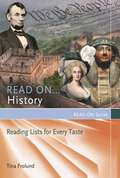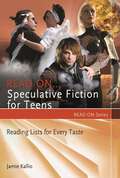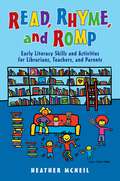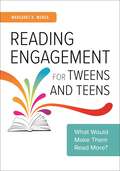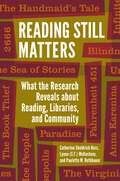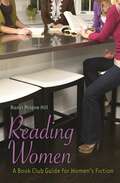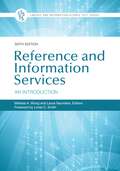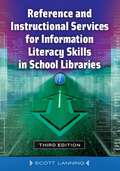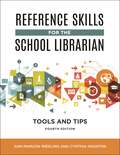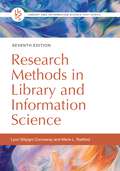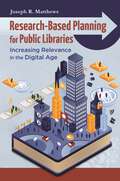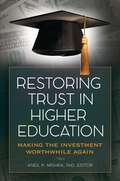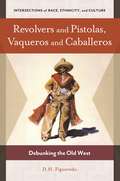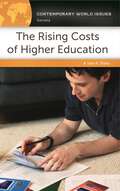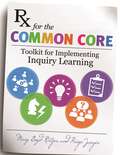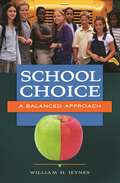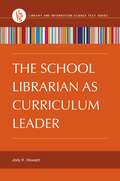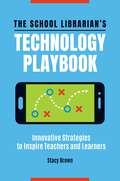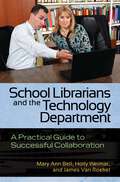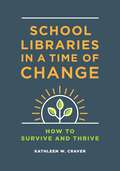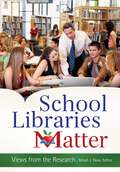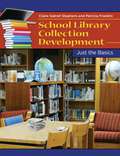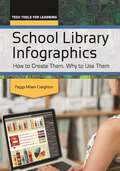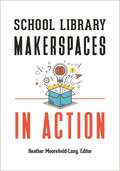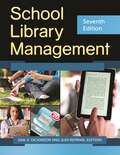- Table View
- List View
Read On…History: Reading Lists for Every Taste (Read On Series)
by Tina FrolundMake history come alive! This book helps librarians and teachers as well as readers themselves find books they will enjoy—titles that will animate and explain the past, entertain, and expand their minds.This invaluable resource offers reading lists of contemporary and classic non-fiction history books and historical fiction, covering all time periods throughout the world, and including practically all manner of human endeavors. Every book included is hand-selected as an entertaining and enlightening read! Organized by appeal characteristics, this book will help readers zero in on the history books they will like best—for instance, titles that emphasize character, tell a specific type of historical story, convey a mood, or are presented in a particular setting. Every book listed has been recommended based on the author's research, and has proved to be a satisfying and worthwhile read.
Read On…Speculative Fiction for Teens: Reading Lists for Every Taste (Read On Series)
by Jamie KallioThis guide offers exciting new reading paths for students who enjoy fantasy, science fiction, and paranormal themes. With over 350 titles organized into their primary appeal characteristics and scores of thematic lists, librarians and educators will benefit from lists of contemporary selections specifically written for teens.Interest in teen fiction has grown in popularity in the last decade, especially within the fantasy and paranormal genres. This timely guide is one of the few books on the subject that lists titles that are written specifically for teens.Read On…Speculative Fiction for Teens features popular, contemporary themes ranging from vampire love and ghost stories to epic fantasy and out-of-this-world science fiction. Each of the five chapters caters to a specific area of interest—story, character, setting, mood, and language—and within the chapter, numerous lists of novels are organized by topic, with the best titles highlighted. Each of the more than 350 listed titles includes bibliographic information and a brief, punchy description.
Read, Rhyme, and Romp: Early Literacy Skills and Activities for Librarians, Teachers, and Parents
by Heather McNeilDesigned to promote literacy in young children and to empower parents, educators, and librarians, this guide is filled with simple strategies, creative activities, and detailed instructions that help make reading fun.Encouraging a love of reading in young children can be a source of both great frustration and immense joy. This handy resource provides essential tips, techniques, and strategies for making early literacy development fun and inspiring a lifelong love of reading.Read, Rhyme, and Romp: Early Literacy Skills and Activities for Librarians, Teachers, and Parents explores the six basic pre-literacy skills that experts agree are necessary for a young child to be ready to learn to read. Special sections within each chapter are dedicated to the specific needs of preschool teachers, parents, and librarians, making the content relevant to different settings. Recommended book lists, personal anecdotes, and literacy-rich activities combine to create an effective and accessible plan for implementing an early literacy program.
Reading Engagement for Tweens and Teens: What Would Make Them Read More?
by Margaret K. MergaIdentifies evidence-backed and easy-to-implement strategies for encouraging young people to read, and helps you to position your library as an indispensable resource for supporting reading.While most reading research focuses on young children, this book looks at how to support reading beyond the early years and into adulthood. Reporting on strong, peer-reviewed research supported by sound theoretical and methodological approaches, it emphasizes the practical implications of these findings, sharing what this means for you in terms of how you can be a powerful positive reading model and influence in young people's lives.Enriched with the voices of today's young people, the book includes quotes that allow readers to decide how to support reading engagement for tweens and teens based on what would make them read more, as expressed in their own words. Engaging and readable, it will be of interest to school and public librarians and can be shared with teachers, parents, and other literacy instructors and advocates.
Reading Still Matters: What the Research Reveals about Reading, Libraries, and Community
by Catherine Sheldrick Ross Lynne (E.F.) McKechnie Paulette M. RothbauerDrawing on scholarly research findings, this book presents a cogent case that librarians can use to work towards prioritization of reading in libraries and in schools.Reading is more important than it has ever been—recent research on reading, such as PEW reports and Scholastic's "Kids and Family Reading Report," proves that fact. This new edition of Reading Matters provides powerful evidence that can be used to justify the establishment, maintenance, and growth of pleasure reading collections, both fiction and nonfiction, and of readers' advisory services. The authors assert that reading should be woven into the majority of library activities: reference, collection building, provision of leisure materials, readers' advisory services, storytelling and story time programs, adult literacy programs, and more.This edition also addresses emergent areas of interest, such as e-reading, e-writing, and e-publishing; multiple literacies; visual texts; the ascendancy of young adult fiction; and fan fiction. A new chapter addresses special communities of YA readers. The book will help library administrators and personnel convey the importance of reading to grant-funding agencies, stakeholders, and the public at large. LIS faculty who wish to establish and maintain courses in readers' advisory will find it of particular interest.
Reading Women: A Book Club Guide for Women's Fiction
by Nanci Milone HillAn indispensable guide for anyone who runs or participates in a book group, this title provides the structure and fun facts needed to examine the genre of women's fiction.Women's fiction covers numerous topics of importance in the lives of women—friendship, love, personal growth, and familial relationships. For this reason, the genre is a hotbed of engaging subjects for book group discussions. Reading Women: A Book Club Guide for Women's Fiction brings together information on over 100 women's fiction titles, providing everything a book group needs to encourage focused, stimulating meetings.Reading Women marshals information that has been, up to this point, either nonexistent or scattered in book club guides. Readers will learn the difference between women's fiction, romance, and chick lit, as well as why these genres provide a rich trove of discussion topics for book groups. Specific entries cover titles from all three genres, offering an author biography, a book summary, bibliographic material, discussion questions, and read-alike information for each book. An additional 50 titles suitable for book group discussions are listed with brief summaries.
Reference and Information Services: An Introduction (Library and Information Science Text Series)
This revised and updated sixth edition of Reference and Information Services continues the book's rich tradition, covering all phases of reference and information services with less emphasis on print and more emphasis on strategies and scenarios.Reference and Information Services is the go-to textbook for MSLIS and i-School courses on reference services and related topics. It is also a helpful handbook for practitioners. Authors include LIS faculty and professionals who have relevant degrees in their areas and who have published extensively on their topics. The first half of the book provides an overview of reference services and techniques for service provision, including the reference interview, ethics, instruction, reader's advisory, and services to diverse populations including children. This part of the book establishes a foundation of knowledge on reference service and frames each topic with ethical and social justice perspectives. The second part of the book offers an overview of the information life cycle and dissemination of information, followed by an in-depth examination of information sources by type—including dictionaries, encyclopedias, indexes, and abstracts—as well as by broad subject areas including government, statistics and data, health, and legal information. This second section introduces the tools and resources that reference professionals use to provide the services described in the first half of the text.
Reference and Instructional Services for Information Literacy Skills in School Libraries
by Scott LanningStudents need to be able to distinguish good information from bad. This book gives you the tools to transmit those essential skills to your students.Being an effective school librarian requires acting as an active instructional partner, an advocate for information literacy and information resources, and a reference librarian. Now in its third edition, this concise book provides you with a solid foundation in providing reference services to students as well as teachers. It details all aspects of providing essential reference services in the context of the AASL Standards, the Common Core State Standards, and the evolving role of today's school librarian.Author Scott Lanning emphasizes service and instruction while addressing topics such as inquiry, critical thinking, building core reference skills, electronic and Web resources, leadership skills, and virtual reference services. The book begins with chapters that discuss information and the information-seeking process. The following sections cover the provision of reference services, methods for teaching information literacy, the use of electronic resources in general, and the creation of library resources that support reference and instruction. The text concludes with an assessment of the value of reference and instruction services to the school and beyond.
Reference Skills for the School Librarian: Tools and Tips
by Ann Marlow Ph.D. Cynthia HoustonDesigned for courses that prepare LIS students for school librarianship, this title teaches basic reference processes, sources, services, and skills and provides authentic school library reference scenarios and exercises.This fourth edition of Reference Skills for the School Librarian: Tools and Tips acknowledges the vital importance of reference skills in school libraries. It focuses on new reference skills for school librarians and includes more online materials such as Webliographies and a glossary. Teaching reference skills and providing reference services to students and staff in schools are extremely important tasks and are required of librarians on a regular basis. Aimed at pre-service and in-service school librarians, this book covers all types of reference materials including almanacs, dictionaries, encyclopedias, atlases, and other standard information sources, giving extra emphasis to the online sources to which students increasingly turn. This edition addresses more online reference resources than previous editions and offers practical suggestions for use in K–12 student instruction.
Research Methods in Library and Information Science (Library and Information Science Text Series)
by Lynn Silipigni Connaway Marie L. RadfordThe seventh edition of this frequently adopted textbook features new or expanded sections on social justice research, data analysis software, scholarly identity research, social networking, data science, and data visualization, among other topics. It continues to include discipline experts' voices.The revised seventh edition of this popular text provides instruction and guidance for professionals and students in library and information science who want to conduct research and publish findings, as well as for practicing professionals who want a broad overview of the current literature.Providing a broad introduction to research design, the authors include principles, data collection techniques, and analyses of quantitative and qualitative methods, as well as advantages and limitations of each method and updated bibliographies. Chapters cover the scientific method, sampling, validity, reliability, and ethical concerns along with quantitative and qualitative methods. LIS students and professionals will consult this text not only for instruction on conducting research but also for guidance in critically reading and evaluating research publications, proposals, and reports.As in the previous edition, discipline experts provide advice, tips, and strategies for completing research projects, dissertations, and theses; writing grants; overcoming writer's block; collaborating with colleagues; and working with outside consultants. Journal and book editors discuss how to publish and identify best practices and understudied topics, as well as what they look for in submissions.
Research-Based Planning for Public Libraries: Increasing Relevance in the Digital Age
by Joseph R. MatthewsThis book will help public library administrators, managers, and board members to better plan, strategize, and understand their communities, enabling public libraries to become dynamic, proactive institutions.Research-Based Planning for Public Libraries: Increasing Relevance in the Digital Age takes readers through a logical and effective process for developing a plan and implementing it within the various functions of the library. Grounded in research and best practices, the book offers practical, easy-to-implement advice and direction for today's public library administrators, managers, and board members. Covering everything from goal-setting, policy-making, and budgeting, to collections, promotions, and access and evaluation, the book details how to better provide and promote access, convey its value to customers, and make the library a more integral part of the community. The author inspires library staff and administrators to reinvent themselves to meet—and overcome—the current challenges they face. The information is specifically tailored towards public librarians, particularly those in management or administration, as well as to LIS faculty and students of public librarianship and library management.
Restoring Trust In Higher Education: Making the Investment Worthwhile Again
by Aneil K. Mishra and J. L. StimpertLeaders from both private and public institutions provide a 360-degree view of the challenges and opportunities facing higher education—and offer a manifesto for restoring relevance and respect.Where is the value in higher education? How can higher education restore its relevance and trust with students and parents? Are there really any meaningful differences between public and private higher education? This volume probes those questions and more, exploring the myriad issues that have led many people to question whether higher education is worth the sacrifices it requires of parents and students. Drawing on the experience and expertise of a wide variety of highly renowned academics, respected government officials, and well-grounded individuals from the private sector, this thought-provoking book offers readers simple but powerful ways to evaluate whether prospective colleges and universities merit the very substantial investment of time, abilities, and financial resources they necessitate. Readers will learn what to look for in a college or university and what questions to ask in selecting an institution of higher education. They will also learn how parents, students, academicians, and other stakeholders can advocate for changes to benefit both higher education and the constituency it serves.
Revolvers and Pistolas, Vaqueros and Caballeros: Debunking the Old West (Intersections of Race, Ethnicity, and Culture)
by D. H. FigueredoThis riveting exposé reveals how a distorted belief in Anglo superiority necessitated the rewriting of American western history, replacing heroic images of Mexican and Spanish cowboys with negative stereotypes.Early Anglo settlers in the Old West crafted negative images of Latinos in part to help justify the takeover of land occupied by Mexicans and Spaniards at the time. Unfortunately, these depictions were perpetuated throughout the 20th century in art, popular culture, and media … eventually reshaping the narrative of the American West to the exclusion of the non-Anglo people. This book contrasts dominant lore with historical reality to provide a broad overview of the history and contributions of Latinos in the Old West.Author D. H. Figueredo sets out to debunk the myths and falsehoods of the American West by chronicling the cultural perceptions that led to such historical inaccuracies. Through spellbinding accounts, chapters address such topics as the legends behind the caballeros, Mexican culture in the Old West, and the search for cities of gold in the Southwest. Arranged chronologically and thematically, the book examines how popular culture diminished the role of the Mexican vaqueros and illustrates how the image of the Anglo cowboy became the iconic symbol of the Old West.
The Rising Costs of Higher Education: A Reference Handbook (Contemporary World Issues)
by John R. ThelinProviding a clear, logical guide to an illogical topic, this book provides an easy-to-understand guide for anyone who wants to successfully navigate the labyrinth of going to college—and paying for the experience.100 years ago, college tuition at prestigious Ivy League colleges such as Harvard and Brown was about $130 per year. Even when adjusted for inflation, today's cost of higher education has increased dramatically—to the point where a college education is shifting further out of reach for many Americans. This book explains the essential concepts in the debate regarding the staggering costs of higher education, supplying ten original essays by higher education policy experts, a lively historical narrative that provides context to current issues, and systematic guides to finding additional sources of information on the subject.Written from a historian's point of view, The Rising Costs of Higher Education: A Reference Handbook explains the economics of higher education in a manner that encourages readers to participate in the discussion on how to control ever-increasing tuition costs. Both college-bound students and parents will come to appreciate how complicated the problem of paying for college is, and grasp the crucial differences between "cost" and "price" in the specific economics of colleges and universities.
Rx for the Common Core: Toolkit for Implementing Inquiry Learning
by Mary Boyd Ratzer Paige JaegerProviding clear explanations of inquiry-based learning in the light of the Common Core, this book is a practical and graphical guide that will serve as a much-needed primer for librarians and educators.Common Core State Standards (CCSS) are putting educators under pressure to examine what works and what doesn't. Even with the best efforts, integrating new strategies into daily practice in the classroom or library can be frustrating. This book will help. Providing a professional development toolkit that trains school librarians and teachers and enables them to train others, it presents a sequence of scaffolded essential questions that results in a customized blueprint for effective teaching. The book assembles background building blocks for inquiry and the Common Core, illustrates and connects key concepts on how to introduce inquiry-based learning, and provides effective tools for igniting the Common Core through inquiry-based learning methods. Developed from the crucible of six years of professional development to real-world audiences with deep experience in teaching and school librarianship, this book makes implementing inquiry learning and embracing the Common Core easier for classroom teachers and school librarians who understand the value of these teaching methods but are unsure of the best way to implement them.
School Choice: A Balanced Approach
by William H. JeynesAre public charter schools more effective than traditional public schools? This book provides quantitative evidence to answer this question and considers a better way to undertake a policy of school choice.School Choice: A Balanced Approach is the most comprehensive examination of traditional public schools, public charter schools, and faith-based schools that has ever been undertaken. By considering and comparing the overall data on these three types of educational systems, it provides insight on likely outcomes of school choice programs. The author's objective is not to advance any particular agenda, but rather to provide readers with an unbiased analysis of research that has been embraced by both the G.W. Bush and Obama administrations that will allow for fresh thinking and the betterment of American education as a whole.Author William H. Jeynes, PhD, asks vital questions regarding the school choice issue that are often overlooked: Which specific programs of school choice are likely to work, and which would likely fail? Is school choice really a boon for the private sector? How might the implementation of school choice programs increase or decrease the financial burden on government budget deficits? This book carefully addresses a relevant topic that ultimately affects every American, making it essential reading for everyone from government officials and educators to students and the general public.
The School Librarian as Curriculum Leader (Library and Information Science Text Series)
by Jody K. HowardOne of the only books to offer a behind-the-scenes look at the role of school librarians in student success, this guide offers everything you'll need to develop, align, and evaluate curriculum with your library collection in mind.This reference provides school library professors with strategies and tips for creating future school leaders out of current LIS students. Drawing upon her extensive experience as a school librarian, author Jody K. Howard heralds the library professional's role as information specialist, instructional partner, and curriculum advocate. Her insider's perspective is rich with tested strategies to help students seamlessly integrate the responsibilities of their multiple roles into daily activities.The work explains the process of curriculum mapping and collection development with an eye on teaching these tools to those new to the profession. The content provides methods for developing guided inquiry lessons in collaboration with teachers, illustrates ways to develop leadership skills while aligning the collection with the curriculum, and offers strategies for working alongside curriculum committees and classroom teachers to build a cohesive educational program. The final chapter explores the roles and responsibilities of school librarians at the district, state, and national level.
The School Librarian's Technology Playbook: Innovative Strategies to Inspire Teachers and Learners
by Stacy BrownUsing concrete examples, The School Librarian's Technology Playbook offers strategies for school librarians to initiate and support innovative practices throughout their school community.The role of school librarians has evolved: no longer do they primarily support teachers with reading and literacy resources. Many librarians now support teachers in integrating technology tools and innovative teaching practices in their classrooms.At her school, author and learning coordinator Stacy Brown has pioneered the transition to innovation and technology use in the classroom. In The School Librarian's Technology Playbook, she showcases different technology tools and innovative strategies that can be incorporated into the classroom, such as 3D printing, augmented reality, green screen applications, gamification, coding, makerEd, and more. She details the many ways in which school librarians can support teachers as they implement these new practices into their curriculum. School librarians will learn how to collaborate with teachers and how to empower them to step outside of their comfort zones to try new tools and teaching methods. Readers of this book will also learn how to support teachers as the technology continues to change in this dynamic educational landscape.
School Librarians and the Technology Department: A Practical Guide to Successful Collaboration
by Mary Ann Bell Holly Weimar James Van RoekelThis handbook provides librarians and technology specialists with the tools to understand the issues and challenges related to their counterparts' jobs, and find ways to work together for the betterment of all concerned.School Librarians and the Technology Department: A Practical Guide to Successful Collaboration was inspired by the authors' collective realization that far too often librarians and technology specialists fail to collaborate successfully, and sometimes even find their groups at odds with one another. This book is the antidote: it is a powerful call to establish and improve relationships between the two for the benefit of the students as well as the librarians and technology specialists themselves.The book begins by providing background information about the history of librarianship and the use of computer technology in schools. The authors trace the origins of the positions related to educational technology, such as "technology specialist," "teacher," and "director." The following chapters describe and address specific concerns of both librarians and technology specialists. Most importantly, this collaborative work offers practical suggestions for cooperation between these two groups of educators as they work together to offer the best possible materials and instructions to students. School Librarians and the Technology Department concludes by hypothesizing what the future holds in the realms of librarianship and technology in this rapidly changing information age.
School Libraries in a Time of Change: How to Survive and Thrive
by Kathleen W. CraverBy becoming practical futurists, school librarians can help their libraries not only to survive sweeping changes in education but to thrive. This book shows how to spot technological trends and use them to your library's advantage.During this time of rapid modernization of technology and educational reform, this book is a must-read for school librarians tasked with ensuring their libraries meet evolving standards. This title provides the research and organizational techniques and skills they need to gain seats at the table of the three power committees: technology, curricula, and strategic planning.School librarians need to collect and publicize national and local school-based evidence that shows the positive correlations between school librarians and student achievement. Craver notes correlative sources and provides ideas to employ them to ensure that school librarians remain indispensable. In addition, acquiring technological skills and becoming expert at their application are paramount for librarians. Even more important is the need for librarians to assume sole responsibility for designing and integrating information literacy and critical thinking skills throughout the curriculum. Craver analyzes studies that show students' inability to discern fact from fiction, ads from news, and information bias in electronic information sources and recommends six actions that school librarians take to ensure that they become active participants in their future rather than its victims.
School Libraries Matter: Views from the Research
by Mirah J. DowAs school districts across the United States increasingly question the need for trained librarians, this collection of research-based evidence helps make the case for a state-licensed librarian in every school.While serving on the AASL legislation committee, Mirah Dow recognized the urgent need to utilize research-based evidence to prove school librarians are much more than an educational luxury. This collection is the result. It brings together school library research studies and findings from the past decade and draws connections to how they can be applied to situations and questions that occur in practice. Taken as a whole, the research underscores that state-licensed, school librarians are a necessity for 21st-century students.Chapters center on important research studies from the past decade that examine data and locate school libraries within operational contexts. Methodologies are explained and findings summarized, while notes clarify practical applications for school librarians. Because each chapter includes a connection to broad realms of theoretical influence in the social sciences, the work will also be relevant to educators and public policymakers, arming them to better communicate research-based links between investments in school libraries and student learning outcomes.
School Library Collection Development: Just the Basics (Just the Basics)
by Claire Gatrell Stephens Patricia FranklinThis practical manual demystifies the process of creating and maintaining a quality school library collection—an invaluable resource for anyone working in a library media center.Today's school librarians have many different responsibilities, but arguably the most important aspect of their job is developing and maintaining a collection that their library customers love. School Library Collection Development: Just the Basics is an accessible, practical manual that explains the fundamentals of purchasing, developing, and managing a collection.Containing information useful to anyone from a paraprofessional working under the guidance of a certified school librarian to a newcomer to the field to a certified media specialist, this book covers all of the basics through best practices. The authors provide much-needed advice on how to add to an existing collection, how to weed books no longer needed, and how to process and inventory that collection. This book is a must-have resource for staff members who are new to school libraries and need an easy-to-read guide to help them quickly learn the job.
School Library Infographics: How to Create Them, Why to Use Them (Tech Tools for Learning)
by Peggy Milam Ph.D.Find out how you can increase the impact of your school library instruction, promotion, and organization with the utilization of infographics created with do-it-yourself tips found within this guidebook.Infographics have become increasingly popular educational tools for visually conveying ideas and information—in class projects, in daily lessons, and for promoting school and library programs. This book—the only one of its kind—helps you create your own computer-generated visuals for your class and library using common software platforms and free web-based applications. A perfect primer for educators with little or no technological savvy, this resource features charts, tables, screenshots, bars, and graphs for making infographics easy to reproduce and create. Author Peggy Milam Creighton discusses the benefits of utilizing visuals with students and provides tips and strategies for creating your own graphics for various educational settings. The reference is organized into three topics: how to create infographics with Microsoft software such as Word, Excel, and PowerPoint; how to use graphics to support school library programs; and why using these visual-based learning tools is important. The work features easy-to-use tutorials, lesson plans, and project ideas for students.
School Library Makerspaces in Action
by Heather Moorefield-LangMaker learning spaces in schools and public libraries are made real through the narratives of professional librarians around the world, comprising the collaborative activities, experiences, and perspectives of librarians as they have implemented makerspaces for students of all ages.School Library Makerspaces in Action is for any librarian looking for inspiration for their own makerspaces, hackerspaces, fablabs, or DIY locations and how to use these spaces in libraries and educational settings. Contributions from authors around the world address the needs of most all readers, including how to provide the staff training necessary for a successful makerspace. Each chapter is written from an author's personal experience, and with only a little fine-tuning and imagination, many of these ideas can be used throughout all levels, disciplines, and subjects in K–12 education and carry over into higher education. The successes and optimism shared in this collection will inspire librarians and educators to think positively about how to implement maker learning locations, train staff, and use makerspaces in their libraries and classrooms to promote and share new ideas.
School Library Management
by Judi Repman Gail K. DickinsonThis book compiles selected articles from Library Media Connection to help school librarians and pre-service librarians learn about how to implement best practices for school library management.At a time when budget cuts threaten the role of the school librarian, dynamic learning experiences can resurrect the usefulness of the library and the role of its staff. The seventh edition of this popular book helps librarians develop engaging school library programs for greater student involvement.Comprised of important articles from Library Media Connection (LMC), School Library Management: Seventh Edition is a compilation of best practices in the field of school library management. An excellent textbook for professors teaching LIS courses, the book contains updates to standards and technologies, and features the latest initiatives guiding practices, including Standards for the 21st Century Learner and Empowering Learners: Guidelines for School Library Programs. Each of the book's five sections features helpful tips from LMC and lists relevant resources for school library management. Selected articles address standards, inquiry, ethics, and information literacy. The book also includes a focus on the role of the school librarian in designing authentic assessments.
